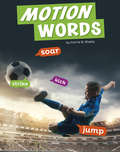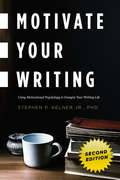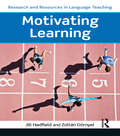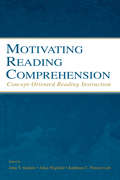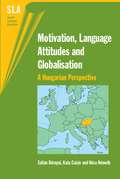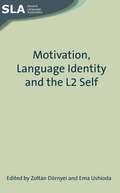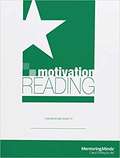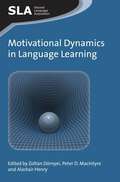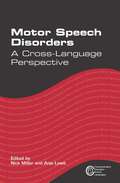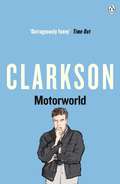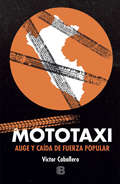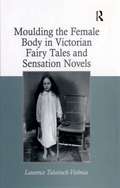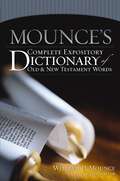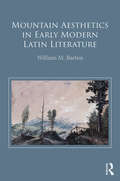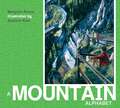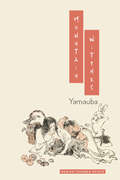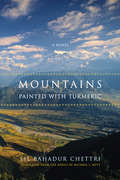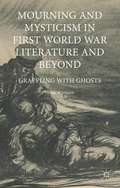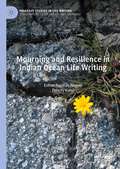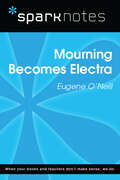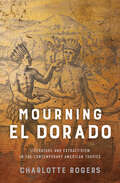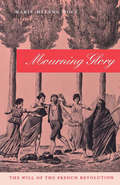- Table View
- List View
Motion Words (Word Play)
by Carrie B. SheelyDive and dunk! Slide and slither! Verbs and motion go hand in hand. Bring verbs to young learners, and watch their vocabularies grow! Words are carefully matched to engaging photos that will keep children captivated from beginning to end.
Motivate Your Writing: Using Motivational Psychology to Energize Your Writing Life
by Stephen P. Kelner Jr.Energize and organize your writing life by tapping into your fundamental motivators.Note: This second edition has been substantially revised and updated, including 10% more content than the first edition.Aspiring and professional writers alike struggle to stay motivated; in the face of distractions, obligations, and procrastination, the desire to write often fails to become the act of writing. Motivated writers, notes the author, are those who have learned to identify their fundamental emotional drives and who have established a writing routine that satisfies those drives. Kelner draws on the research and insights of motivational psychology to show writers how to harness the energy of these fundamental motivators. With a degree in motivational psychology, Kelner applies not only his training in the field but also his own original research into the motivational patterns typical of writers. Depending on their motivational profile, different writers will respond best to different kinds of feedback and rewards and will function best in different kinds of environments. Kelner explains the basic drives of power, affiliation, and achievement; he shows how these drives are manifested in a wide variety of behaviors; and he provides self-assessment tools to construct your own motivational profile. In clear and accessible terms, and with numerous examples and anecdotes, Kelner shows writers how they can identify their own primary motivations and use that knowledge to arrange their work habits and energize their writing lives.
Motivating Learning (Research and Resources in Language Teaching)
by Zoltán Dörnyei Jill HadfieldMotivation is a vital element in learning, and the most commonly cited explanation for success or failure in language learning. Jill Hadfield and Zoltán Dörnyei present a new theory of motivation centred around the notion of the "˜Ideal Future Language Self", arguing that if students have a rich and inspiring vision of themselves as successful future language learners and users, they will be motivated to work hard to actualise the vision and become that learner. This book: - integrates the latest research in language teaching with innovative classroom practice - offers suggestions on how the various components of the theory could be structured into a teaching sequence - includes a variety of imaginative classroom activities designed to aid both student and teacher in creating and actualising the Ideal Self through visualisation, goal setting, task identification and planning, and a selection of appropriate learning strategies. - shows how teachers can undertake motivation-related research in their own classrooms. This is an ideal guide to and activity book for the theory and practice of motivation in language learning for students and teachers alike.
Motivating Reading Comprehension: Concept-Oriented Reading Instruction
by Allan WigfieldConcept Oriented Reading Instruction (CORI) is a unique, classroom-tested model of reading instruction that breaks new ground by explicitly showing how content knowledge, reading strategies, and motivational support all merge in successful reading instruction. A theoretical perspective (engagement in reading) frames the book and provides a backdrop for its linkage between hands-on science activities and reading comprehension. Currently funded by the Interagency Educational Research Initiative (IERI), this model has been extensively class tested and is receiving national attention that includes being featured on a PBS special on the teaching of reading.Key features of this outstanding new volume include:*Theoretical Focus--CORI's teaching framework revolves around the engagement perspective of reading: how engaged reading develops and the classroom contexts and motivational supports that promote it.*Content-Area Focus--Although science is the content area around which CORI has been developed, its basic framework is applicable to other content areas.*Focus on Strategy Instruction--CORI revolves around a specific set of reading strategies that the National Reading Panel (2000) found to be effective. In some current CORI classrooms collaborating teachers implement all aspects of CORI and in other classrooms teachers implement just the strategy instruction component. *Illustrative Vignettes and Cases--Throughout the book vignettes and mini-case studies convey a situated view of instructional practices for reading comprehension and engagement. A detailed case study of one teacher and of the reading progress of her students is featured in one chapter. This book is appropriate for graduate and advanced undergraduate students in education and psychology, for practicing teachers, and for researchers in reading comprehension and motivation.
Motivation, Language Attitudes and Globalisation
by Kata Csizer Zoltan DornyeiThis volume presents the results of the largest ever language attitude/motivation survey in second language studies. The research team gathered data from over 13,000 Hungarian language learners on three successive occasions: in 1993, 1999 and 2004. The examined period covers a particularly prominent time in Hungary's history, the transition from a closed, Communist society to a western-style democracy that became a member of the European Union in 2004. Thus, the book provides an 'attitudinal/motivational flow-chart' describing how significant sociopolitical changes affect the language disposition of a nation.
Motivation, Language Identity and the L2 Self
by Ema Ushioda Zoltan DornyeiDue to its theoretical and educational significance within the language learning process, the study of L2 motivation has been an important area of second language acquisition research for several decades. Over the last few years L2 motivation research has taken an exciting new turn by focusing increasingly on the language learner's situated identity and various self-perceptions. As a result, the concept of L2 motivation is currently in the process of being radically reconceptualised and re-theorised in the context of contemporary notions of self and identity. With contributions by leading European, North American and Asian scholars, this volume brings together the first comprehensive anthology of key conceptual and empirical papers that mark this important paradigmatic shift.
Motivation Reading Level 3
by Michael L. LujanAddress the rigor, depth, and complexity seen in the Common Core Standards with Motivation Reading. It unpacks and clarifies the Common Core Standards while providing opportunities for formative assessments and performance tasks. It also provides high-interest selections and selected-response assessments aligned to the Common Core Standards. Motivation Reading is built for the Common Core.
Motivation Reading Level 4: TEKS- Based Alignment to STAAR
by Mentoring Minds Editorial StaffCritical Thinking for Life! Reading Test Prep
Motivational Dynamics in Language Learning
by Zoltán Dörnyei Peter D. MacintyreThis landmark volume offers a collection of conceptual papers and empirical research studies that investigate the dynamics of language learning motivation from a complex dynamic systems perspective. The contributors include some of the most well-established scholars from three continents, all addressing the question of how we can understand motivation if we perceive it as continuously changing and evolving rather than as a fixed learner trait. The data-based studies also provide useful research models and templates for graduate students and scholars in the fields of applied linguistics and SLA who are interested in engaging with the intriguing area of examining language learning in a dynamic vein.
Motor and Sensory Processes of Language (Neuropsychology and Neurolinguistics Series)
by Eric Keller Myrna GopnikPublished in 1987, Motor and Sensory Processes of Language is a valuable contribution to the field of Cognitive Psychology.
Motor Speech Disorders
by Anja Lowit Nick MillerMotor speech disorders are a common accompaniment of a whole range of neurological conditions, from stroke, brain injury and Parkinson's disease through to many rarer conditions. This book aims to aid understanding of the nature of motor speech disorders from a cross-language perspective, in contrast to the largely English-centric nature of research and practice recommendations to date. The book looks not just at how these motor speech disorders are assessed and treated in other countries, but also examines how underlying speech impairments differ according to the language someone speaks. The book studies the underlying neurological, neurophysiological and neurophonetic characteristics of motor speech disorders in different language contexts, and discusses the implications these have for clinical rehabilitation. This significantly adds to debates around the theoretical understanding and clinical management of motor speech disorders.
Motorworld
by Jeremy ClarksonJeremy Clarkson invites us to Motorworld, his take on different cultures and the cars that they drive.There are ways and means of getting about that don't involve four wheels, but in this slice of vintage Clarkson, Jeremy isn't much interested in them.Back in 1996, he took himself off to twelve countries (okay, eleven - he goes to America twice) in search of the hows, whys and wherefores of different nationalities and their relationships with cars. There were a few questions he needed answers to:* Why, for instance, is it that Italians are more interested in looking good than looking where they are going?* Why do Indians crash a lot?* How can an Arab describe himself as 'not a rich man' with four of the world's most expensive cars in his drive? * And why have the otherwise neutral Swiss declared war on the car?From Cuba to Iceland, Australia to Vietnam, Japan to Texas, Jeremy Clarkson tells us of his adventures on and off four wheels as he seeks to discover just what it is that makes our motorworld tick over. _____________Praise for Jeremy Clarkson:'Brilliant . . . laugh-out-loud' Daily Telegraph'Outrageously funny . . . will have you in stitches' Time Out'Very funny . . . I cracked up laughing on the tube' Evening Standard
Mototaxi
by Víctor Caballero"Mototaxi no busca favorecer o perjudicar a nadie. La historia se encargará de eso". Sumergirse detrás de cámaras es lo opuesto al oficio del youtuber. Ponerse delante de un lente en la comodidad de tu habitación es totalmente lo contrario a salir a la calle a buscar la historia que nadie registró en video. Con Mototaxi, Víctor Caballero ha logrado transitar airoso ese camino. Conocido por El diario de Curwen, el canal de Youtube que se convirtió en una referencia ineludible para toda una generación, en este libro Caballero demuestra que su esencia es el periodismo, sin importar su envase. Una narración apasionada y detallista del período más turbulento de la democracia peruana del siglo XXI, contada desde la perspectiva de "los malos" de la historia: Keiko Fujimori y su corte. Como en sus exitosos videos, aquí lo más importante son los datos, los hechos, la veracidad. Esa siempre fue la esencia de Caballero y ese es el tronco principal de este minucioso recuento de todos los atropellos de la mototaxi que, ahora lo sabemos, condujo nuestros destinos.
Moulding the Female Body in Victorian Fairy Tales and Sensation Novels
by Laurence Talairach-VielmasLaurence Talairach-Vielmas explores Victorian representations of femininity in narratives that depart from mainstream realism, from fairy tales by George MacDonald, Lewis Carroll, Christina Rossetti, Juliana Horatia Ewing, and Jean Ingelow, to sensation novels by Wilkie Collins, Mary Elizabeth Braddon, Rhoda Broughton, and Charles Dickens. Feminine representation, Talairach-Vielmas argues, is actually presented in a hyper-realistic way in such anti-realistic genres as children's literature and sensation fiction. In fact, it is precisely the clash between fantasy and reality that enables the narratives to interrogate the real and re-create a new type of realism that exposes the normative constraints imposed to contain the female body. In her exploration of the female body and its representations, Talairach-Vielmas examines how Victorian fantasies and sensation novels deconstruct and reconstruct femininity; she focuses in particular on the links between the female characters and consumerism, and shows how these serve to illuminate the tensions underlying the representation of the Victorian ideal.
Mounce's Complete Expository Dictionary of Old and New Testament Words
by William D. MounceFor years, Vine’s Expository Dictionary has been the standard word study tool for pastors and laypeople, selling millions of copies. But sixty-plus years of scholarship have shed extensive new light on the use of biblical Greek and Hebrew, creating the need for a new, more accurate, more thorough dictionary of Bible words. William Mounce, whose Greek grammar has been used by more than 100,000 college and seminary students, is the editor of this new dictionary, which will become the layperson’s gold standard for biblical word studies. Mounce’s is ideal for the reader with limited or no knowledge of Greek or Hebrew who wants greater insight into the meanings of biblical words to enhance Bible study. It is also the perfect reference for busy pastors needing to quickly get at the heart of a word’s meaning without wading through more technical studies. What makes Mounce’s superior to Vine’s? · The most accurate, in-depth definitions based on the best of modern evangelical scholarship · Both Greek and Hebrew words are found under each English entry (Vine’s separates them) · Employs both Strong’s and G/K numbering systems (Vine’s only uses Strong’s) · Mounce’s accuracy is endorsed by leading scholars
Mountain Aesthetics in Early Modern Latin Literature
by William M. BartonIn the late Renaissance and Early Modern period, man’s relationship to nature changed dramatically. An important part of this change occurred in the way that beauty was perceived in the natural world and in the particular features which became privileged objects of aesthetic gratification. This study explores the shift in aesthetic attitude towards the mountain that took place between 1450 and 1750. Over the course of these 300 years the mountain transformed from a fearful and ugly place to one of beauty and splendor. Accepted scholarly opinion claims that this change took place in the vernacular literature of the early and mid-18th century. Based on previously unknown and unstudied material, this volume now contends that it took place earlier in the Latin literature of the late Renaissance and Early Modern period. The aesthetic attitude shift towards the mountain had its catalysts in two broad spheres: the development of an idea of ‘landscape’ in the geographical and artistic traditions of the 16th century on the one hand, and the increasing amount of scientific and theological investigation dedicated to the mountain on the other, reaching a pinnacle in the late 17th and early 18th centuries. The new Latin evidence for the change in aesthetic attitude towards the mountain unearthed in the course of this study brings material to light which is relevant for the current philosophical debate in environmental aesthetics. The book’s concluding chapter shows how understanding the processes that produced the late Renaissance and Early Modern shift in aesthetic attitude towards the mountain can reveal important information about the modern aesthetic appreciation of nature. Alongside a standard bibliography of primary literature, this volume also offers an extended annotated bibliography of further Latin texts on the mountains from the Renaissance and Early Modern period. This critical bibliography is the first of its kind and constitutes an essential tool for further study in the field.
A Mountain Alphabet (ABC Our Country)
by Margriet RuursMountains are an impressive sight anywhere in the world but those of the western mountain region of North America offer riches that are truly unique. This lavishly illustrated picture book presents snowcapped peaks, emerald lakes, tall pines and magnificent maples, and a range of birds and animals that will fill readers of all ages with wonder.The treasures and mysteries of nature are depicted in twenty-six full-color paintings, each with a line of alliterative text. Objects that begin with that letter of the alphabet are waiting to be discovered in each illustration. Complete with detailed information about each setting painted, this is a visually and mentally stimulating experience – from A to Z.
Mountain Witches: Yamauba
by Noriko T. ReiderMountain Witches is a comprehensive guide to the complex figure of yamauba—female yōkai often translated as mountain witches, who are commonly described as tall, enigmatic women with long hair, piercing eyes, and large mouths that open from ear to ear and who live in the mountains—and the evolution of their roles and significance in Japanese culture and society from the premodern era to the present. In recent years yamauba have attracted much attention among scholars of women’s literature as women unconstrained by conformative norms or social expectations, but this is the first book to demonstrate how these figures contribute to folklore, Japanese studies, cultural studies, and gender studies. Situating the yamauba within the construct of yōkai and archetypes, Noriko T. Reider investigates the yamauba attributes through the examination of narratives including folktales, literary works, legends, modern fiction, manga, and anime. She traces the lineage of a yamauba image from the seventh-century text Kojiki to the streets of Shibuya, Tokyo, and explores its emergence as well as its various, often conflicting, characteristics. Reider also examines the adaptation and re-creation of the prototype in diverse media such as modern fiction, film, manga, anime, and fashion in relation to the changing status of women in Japanese society. Offering a comprehensive overview of the development of the yamauba as a literary and mythic trope, Mountain Witches is a study of an archetype that endures in Japanese media and folklore. It will be valuable to students, scholars, and the general reader interested in folklore, Japanese literature, demonology, history, anthropology, cultural studies, gender studies, and the visual and performing arts.
Mountains Painted with Turmeric
by Lil Bahadur ChettriSince its publication in the late 1950s, Mountains Painted with Turmeric has struck a chord in the hearts of hundreds of thousands of Nepali readers. Set in the hills of far eastern Nepal, the novel offers readers a window into the lives of the people by depicting in subtle detail the stark realities of village life.Carefully translated from the original text, Mountains Painted with Turmeric tells the story of a peasant farmer named Dhané (which means, ironically, "wealthy one") who is struggling to provide for his wife and son and arrange the marriage of his beautiful younger sister. Unable to keep up with the financial demands of the "big men" who control his village, Dhané and his family suffer one calamity after another, and a series of quarrels with fellow villagers forces them into exile. In haunting prose, Lil Bahadur Chettri portrays the dukha, or suffering and sorrow, endured by ordinary peasants; the exploitation of the poor by the rich and powerful; and the social conservatism that twists a community into punishing a woman for being the victim of a crime. Chettri describes the impoverishment, dispossession, and banishment of Dhané's family to expose profound divisions between those who prosper and those who are slowly stripped of their meager possessions. Yet he also conveys the warmth and intimacy of village society, from which Dhané and his family are ultimately excluded.
Mourning and Mysticism in First World War Literature and Beyond
by George M. JohnsonHow did people respond to the overwhelming loss of loved ones during the First World War? Many took their lead from iconic early twentieth-century writers, including Sir Arthur Conan Doyle, Sir Oliver Lodge, J. M. Barrie, Rudyard Kipling, Virginia Woolf, Wilfred Owen, and Aldous Huxley, among others, who embraced some form of mysticism as a means of coping. These figures had experienced profound losses and even trauma in their early lives, sensitizing them to losses of loved ones during thewar and making these writers receptive to the possibility of communicating with spirits. Most of these writers had become fascinated with the work of Frederic Myers and other key psychical researchers regarding potential extensions of personality, including telepathy, clairvoyance, and automatic writing, phenomena which supported the possibility that personality survived death. Mourning and Mysticism in First World War Literature and Beyond skilfully weaves psychology, history, psychobiography and literary analysis to show that these writers' engagement with mysticism and spiritualism in particular was not deluded, but at least in some situations constituted a more ethical, creative and therapeutic form of mourning than drawing solace from state-sanctioned representations of mourning such as war memorials.
Mourning and Resilience in Indian Ocean Life Writing (Palgrave Studies in Life Writing)
by Esther Pujolràs-Noguer Felicity HandThis volume examines a selection of life writing in English by authors from the South West Indian Ocean, namely South Africa, East Africa, Mauritius and Sri Lanka. The two motifs that run through the chapters – mourning and resilience – are theoretical frameworks that have so far not been brought into conversation in this way. The combination of trauma studies and autobiographical analysis sharpens the focus of the discussions on Indian Ocean life writing, privileging an Indian Ocean imaginary that is transnational and cross-oceanic in its orientation and pointing to networks of connections that transcend the nation state, which is often the origin of trauma in the first place. Filling a gap in Indian Ocean studies in its close readings of trauma and resilience, the book also broadens perspectives on postcolonial life writing since little attention has been paid so far to Indian Ocean autobiographical literary products. By the same token, the volume also enriches the field of Indian Ocean literary studies by incorporating life writing as an aesthetic strategy which helps to configure Indian Ocean subjectivities.
Mourning Becomes Electra (SparkNotes Literature Guide Series)
by SparkNotesMourning Becomes Electra (SparkNotes Literature Guide) by Eugene O'Neill Making the reading experience fun! Created by Harvard students for students everywhere, SparkNotes is a new breed of study guide: smarter, better, faster. Geared to what today's students need to know, SparkNotes provides: *Chapter-by-chapter analysis *Explanations of key themes, motifs, and symbols *A review quiz and essay topicsLively and accessible, these guides are perfect for late-night studying and writing papers
Mourning El Dorado: Literature and Extractivism in the Contemporary American Tropics (New World Studies)
by Charlotte RogersWhat ever happened to the legend of El Dorado, the tale of the mythical city of gold lost in the Amazon jungle? Charlotte Rogers argues that El Dorado has not been forgotten and still inspires the reckless pursuit of illusory wealth. The search for gold in South America during the colonial period inaugurated the "promise of El Dorado"—the belief that wealth and happiness can be found in the tropical forests of the Americas. That assumption has endured over the course of centuries, still evident in the various modes of natural resource extraction, such as oil drilling and mining, that characterize the region today.Mourning El Dorado looks at how fiction from the American tropics written since 1950 engages with the promise of El Dorado in the age of the Anthropocene. Just as the golden kingdom was never found, natural resource extraction has not produced wealth and happiness for the peoples of the tropics. While extractivism enriches a few outsiders, it results in environmental degradation and the subjugation, displacement, and forced assimilation of native peoples. This book considers how the fiction of five writers—Alejo Carpentier, Wilson Harris, Mario Vargas Llosa, Álvaro Mutis, and Milton Hatoum—criticizes extractive practices and mourns the lost illusion of the forest as a place of wealth and happiness.
Mourning Glory
by Marie-Hélène HuetMourning Glory sheds light on troubled times as it shows how passion and prejudice, grief and denial all contributed to the continuing creation of a revolutionary legacy that still affects our understanding of the nature of language and history.
